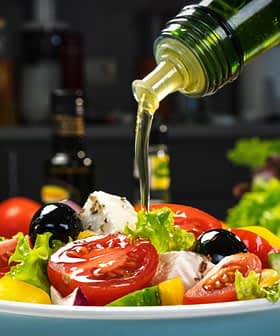Extra Virgin Olive Oil Reduces Postprandial Glucose After High GI Meal in Type 1 Diabetes
New research shows that extra virgin olive oil reduces postprandial glucose in type 1 diabetics after consuming a high glycemic index meal
 Olive Oil Times
Olive Oil TimesMaintaining blood glucose control is extremely important for both type 1 and type 2 diabetics. To do so it is often recommended that diabetics consume low glycemic index foods as a large proportion of their daily intake. And monitoring the quantity of carbohydrate consumed is common practice.
The glycemic index is a measure of carbohydrate quality and shows how quickly different foods cause blood glucose to rise. Low glycemic index foods are those categorized as 55 or below. High glycemic foods are above 55. The higher the index, the more rapidly blood glucose is affected. To measure the response to various foods and meals, postprandial, also known as post meal, blood glucose is commonly recorded by diabetics.
A recent study by Bozzetto and Colleagues, from Federico II University in Naples, Italy, published in Diabetes Care, evaluated whether fat quality could influence postprandial glucose response in the context of high or low glycemic index meals in type 1 diabetes patients.
The study recruited 13 type 1 diabetic patients on insulin pumps in a randomized crossover trial where they consumed two series of meals, high glycemic and low glycemic, composed of the same carbohydrate amount but with differing fat quality — low fat, butter (saturated fat), or extra virgin olive oil (EVOO; monounsaturated fat).
As was expected, there was a significant difference in postprandial glucose in response to a high glycemic index meal compared to a low glycemic index meal, especially in the first 3 hours where blood glucose was significantly higher after consuming the high glycemic meal.
However, after consuming the high glycemic meal it was shown that EVOO resulted in a significantly lower effect on postprandial blood glucose than either butter or low fat. This result was particularly different in the 0 – 3 hour incremental area under the curve. In this instance, they found no significant differences between the groups for low glycemic index meals.
The authors concluding that:
“Using EVOO in an HGI [high glycemic index] meal attenuates the early postprandial glucose response… Therefore, an optimal prandial insulin administration would require considering, in addition to the quantity of carbohydrates, the quality of both carbohydrate and fat.”
This is only a small study but it does indicate that fat quality could in fact be a very important consideration for the everyday diets of diabetics and may be particularly useful during dietary transition when high glycemic foods may still be consumed more frequently.





